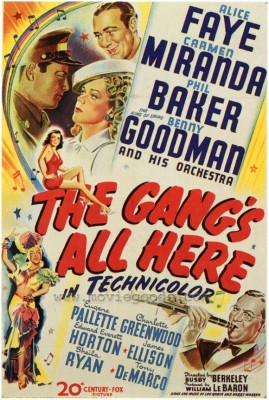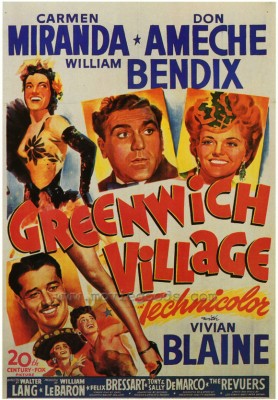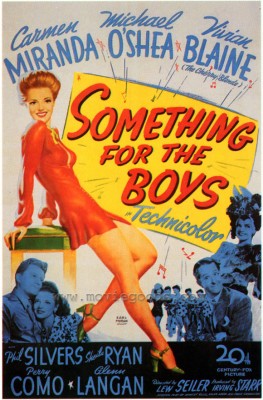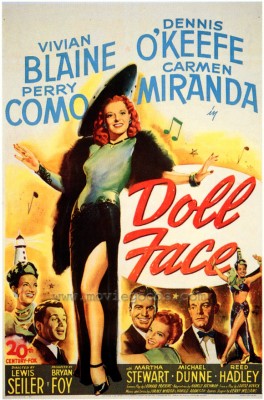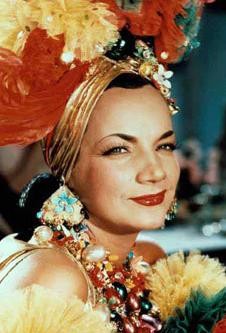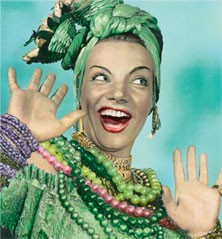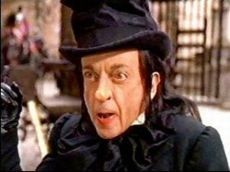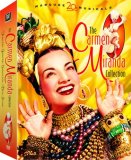| Reviews & Columns |
|
Reviews DVD TV on DVD Blu-ray 4K UHD International DVDs In Theaters Reviews by Studio Video Games Features Collector Series DVDs Easter Egg Database Interviews DVD Talk Radio Feature Articles Columns Anime Talk DVD Savant Horror DVDs The M.O.D. Squad Art House HD Talk Silent DVD
|
DVD Talk Forum |
|
|
| Resources |
|
DVD Price Search Customer Service #'s RCE Info Links |
|
Columns
|
|
|
Carmen Miranda Collection (The Gang's All Here / Greenwich Village / Something for the Boys / Doll Face / If I'm Lucky), The
The Carmen Miranda Collection is an attractively packaged set of five films - The Gang's All Here (1943), Greenwich Village, Something for the Boys (both 1944), Doll Face (1945), and If I'm Lucky (1946). These are highly repetitious films best enjoyed spaced out months apart, but enjoyable and interesting for reasons not always intended. As with most of Fox's classic library titles of recent years, the transfers and especially the supplements are excellent. This is an extremely attractive package of material.
The Gang's All Here
Unquestionably the main attraction is this cult Busby Berkeley musical, his first in Technicolor and about the last to incorporate the eye-popping staging techniques famously employed in his Warner Bros. backstage musicals of the early- and mid-1930s. The 103-minute film is practically wall-to-wall music, allowing for only the flimsiest of plotlines: Tenth-billed James Ellison, former juvenile lead of the Hopalong Cassidy movies, plays Andy Mason, a lovesick soldier who falls for nightclub singer Edie Allen (Alice Faye), and she for him. Trouble is she doesn't realize that he's son of wealthy businessman Andrew Mason Sr. (Eugene Pallette), whose good friends the Potters (Charlotte Greenwood and Edward Everett Horton) have a daughter, Vivian (Shelia Ryan), already unofficially engaged to Andy.
Like a lot of Fox musicals from this period, it's crammed with popular acts that have nothing to do with the story: Benny Goodman and His Orchestra perform several numbers**, third-billed emcee/comedian Phil Baker hangs around without doing much of anything, dancer Tony De Marco shares the limelight.
Such films are more like wartime Grammy Awards shows than movies, with a variety of disparate acts singing and dancing their way through one big production number after another. In one sense these films have become dated more than practically any other kind of Hollywood musical. Where 21st century audiences can still relate to the job-on-the-line chorus girls of Warners' backstage musicals or get sucked into Gene Kelly's romantic aspirations in On the Town or It's Always Fair Weather, story and in this case especially any semblance of reality is out the window in Fox's Technicolor musicals, movies watched rather then experienced.
In this instance, from a visual standpoint The Gang's All Here is absolutely spectacular eye candy, instantly recognizable as Berkeley's work yet more surreal than anything he did previously for Samuel Goldwyn, Warner Bros., or MGM. (For The Gang's All Here, he was on a loan-out from MGM.) Long before Martin Scorsese, Paul Thomas Anderson and others fell in love with lengthy Steadicam shots, long even before Orson Welles' famous opening to Touch of Evil, Berkeley was going nuts with roving crane shots that seem to go on forever, swooping down on and around stars and extras alike in tight close-ups, surveying the people populating his massive sets. The fluidity of the camera, which seems to be in motion about half of the film's running time, leaves a strong impression, while two big numbers, Carmen's "The Lady in the Tutti-Frutti Hat" and "The Polka Dot Polka," the big finale, once seen are never to be forgotten.
The former is just about the ultimate Carmen Miranda number, particularly in its famously surreal final shot, of Carmen wearing what appears to be a hatful of giant bananas stretching skyward into infinity. There's a tendency to read the five-foot rubber bananas the chorus girls dance with as colossal phallic symbols but that's a little too obvious even for Berkeley, whose pre-Code Warner Bros. musicals were far less innocent than this. But the real treasure here is Berkeley's "Polka Dot Polka," as bizarre a number as Hollywood ever produced, incorporating neon hula hoops, women in Cat Women of the Moon-like leotard outfits, kaleidoscopic imagery, and disembodied heads of the starring cast ascending into the heavens, including frog-faced Eugene Pallette, hilariously croaking through some lyrics.
One has to feel sorry for Alice Faye, whose "No Love, No Nothin'" (by Harry Warren and Leo Robin) is a great expression of the loneliness felt by millions of a wives and girlfriends left behind by their men as they fought in Europe and the Pacific. It's the kind of song that must really have resonated with 1943 audiences but which, sadly, contemporary viewers merely tolerate today.
Greenwich Village
Of considerably less interest is this fun but utterly unexceptional musical, definitely a lowercase "A." For no good reason a period film set in 1922 New York, this was shot mainly on a colorful but inauthentic redressed section of the Fox backlot. Greenwich Village tells the story of Wichita-born, wide-eyed aspiring classical composer Kenneth Harvey (Don Ameche), armed with a brand-new concerto and a few thousand bucks in his bank account. Speakeasy owner Danny O'Mara (William Bendix), himself an aspiring Ziegfeld-type, at first is drawn to Ken's bankroll but later wants to re-orchestrate Ken's music for his Greenwich Village Gaieties' socko finish.
Meanwhile, Ken is marked by con artist Hofer (Felix Bresshart), who promises to introduce Ken to his "good friend," famed composer-conductor Kavosky (Emil Rameau), a Leopold Stokowski type. Ken also falls for Danny's headliner, singer Bonnie Watson (Vivian Blaine), whom Danny also loves.
Carmen Miranda is top-billed but, as usual, relegated to the sidelines, again playing the best friend and confidant of the heroine. Her three numbers, including the Eubie Blake standard "I'm Just Wild About Harry" (hardly optimal material for Miranda) are fun but unexceptional, rather like her role. The film is worth sticking through to the end, if only for a brief, outrageous little scene where she tries to convince an Irish cop that she too is hails from Éire.
Mainly the film is watchable for its stars. This was Vivian Blaine's first major role after a quick build-up in Fox's B-movies; before this she appeared in Laurel & Hardy's unambitious B-comedy Jitterbugs (1943). Don Ameche has charm to spare, so much so that you're really in his corner, so well does he sell the cornball material (much more than Ellison in The Gang's All Here, who comes off as pretty clueless). An immediately recognizable Adolph Green and Betty Comden are glimpsed in an early party sequence, though I didn't spot Judy Holliday, in there too somewhere collectively as "The Revuers," though their big number, reportedly shot but cut from the film, leaves them as little more than line-less extras.
Something for the Boys
Entertaining wartime hokum, this 1943 Cole Porter Broadway show is shorn 10 of its 11 songs (!) for the film version, replaced by generic Jimmy McHugh/Harold Adamson numbers like "Climbin' Up Dem Golden Stairs" and "Samba-Boogie." It's utterly predictable and silly but entertaining thanks to its cast, especially Miranda, Phil Silvers, and a few surprising uncredited faces here and there.
Nightclub dancer Blossom Hart (Vivian Blaine), war plant factory worker Chiquita Hart (top-billed Carmen Miranda), and shyster Harry Hart (Phil Silvers) are cousins (yes, I know) who inherit a Southern plantation from their late uncle. The likes of a bloodline this unconvincing would not be seen again until Sean Connery, Dustin Hoffman, and Matthew Broderick played father-son-grandson in Family Business (1989). Then again, whattya expect from a Fox musical, realism?
The trio finds the plantation (later seen in The Alligator People!) in sorry shape, and are quick to accept an offer from Sgt. Rocky Fulton (Michael O'Shea), former bandleader, to turn the place over to the army as a home for soldiers' wives. But money is needed to whip the place into shape and in the tradition of the Mickey Rooney-Judy Garland musicals over at MGM, come up with the perfect solution: "Let's put on a show!"
Ah, but standing in their way are obnoxious rich girl Melanie Walker (Shelia Ryan) and a stuffy, by-the-book lieutenant (Glenn Langan, future Amazing Colossal Man).
Perry Como's on hand to sing a few songs, often crooning to girlfriend Cara Williams (unbilled). Rory Calhoun, Judy Holliday, and The Mickey Mouse Club's Jimmy Dodd likewise make unbilled appearances in bit parts or as extras, but the real surprise for this reviewer was spotting actor Murray Hamilton (The Hustler, Jaws), in a role not yet listed on the IMDb, whose entire part consists of singing "I gotta shoes! I gotta shoes! I gotta shoes!"
Blaine and O'Shea are okay, and Sheila Ryan is fun in a really bitchy part, but the film's main attractions are Silvers and Miranda. Silvers' conman is a virtual dry-run for his great success as Sgt. Bilko a decade later. Fans of his wonderful sitcom will find a familiar persona in Harry Hart. Silvers does an incredible spit take, and late in the film sings a wild, bizarre number, a goofy tribute called "Southland."
Miranda, again nudged off to the sidelines, nonetheless performs two highly effective numbers, better than anything so far outside of "The Lady in the Tutti Frutti Hat": "Batuca Nega" is the first song in the set in which Miranda actually gets to sing in her native Portuguese throughout; one really gets a sense of her talent here. Also, the film concludes with another strong number, "Samba Boogie," which has some good dancing with Miranda in the thick of it.
In a curious subplot perhaps inspired by a real-life incident involving Lucille Ball and a nest of Japanese spies, Miranda's character is cursed with fillings that constantly pick up radio signals, which prove to be a blessing in disguise when she wants to help out Rocky during some war games.
Doll Face
In black & white and running barely 80 minutes, Doll Face unequivocally moves Carmen Miranda downward from lowercase "A-musical" star into the realm of high-end Bs. Further, she drops to fourth billing in the credits behind Perry Como and, even worse, stands around on the sidelines watching Martha Stewart (not the homemaking diva) sing three songs while she has to wait until the movie's almost over before her one number.
The picture is based on a vaguely autobiographical play by Gypsy Rose Lee, credited here under her birth name, Louise Hovick. Vivian Blaine, looking like she's had plastic surgery since Something for the Boys stars as Burly-Q queen Mary Elizabeth "Doll Face" Carroll. Of course, by 1946 when this was made the Burlesque houses still in operation were essentially a venue for strippers and off-color comics but, this being a Fox film for the masses, the performers keep their clothes on. Everything is quite innocent, replaced with unrefined characterizations - not quite Damon Runyon, but close.
When Doll Face is unable to land a spot in Flo Hartman's (Reed Hadley, later a prolific voice actor on innumerable Italian imports) high-class show, boyfriend/manager Michael Francis "Mike" Hannegan (Dennis O'Keefe) decides to stage his own Broadway extravaganza, using all the established talent from his Gayety Burlesque house. They include crooner Nicky Ricci (Como), Brazilian bombshell Chita Chula (Miranda), and ambitious singer Frankie Porter (Stewart). To whip up publicity for Doll Face and the show Mike engages the services of intellectual writer Frederick Manly Gerard (Stephen Dunne) to ghostwrite Doll Face's autobiography, Genius de Milo. Trouble is, predictably, the snobby Park Avenue Frederick falls for Doll Face and starts muscling in on Mike's girl.
It's more than a little ironic that Miranda, here quite subdued, would end up a two-bit novelty act in Burlesque, and sad that in an unfunny in-joke Mike promises Chita will be "another Carmen Miranda," for which the real Miranda expresses nothing but contempt. The movie does have its moments, but they tend to be unintended bits of weirdness.
One incredible subplot involves a romance between easy-going Nicky and fiery redhead Frankie. Throughout the film, Mike actively encourages Nicky to commit domestic violence: "Women and carpets," he says, "They're much better when beaten regularly!" Near the end of the film Nicky finally listens to Mike's "good advice" and almost socks Frankie in the jaw. This she regards as a major turn-on and the two lovers walk off happily into the sunset.
The film features one of Perry Como's standards, "Dig You Later (A-Hubba Hubba Hubba)" but, this song having been written while the war was still going on (though the film was released well into the American Occupation; I doubt this played there), offers lyrics that make light of the Tokyo fire-bombings!
I got it from a guy who was in the kno'
It was mighty smoky over Tokyo!
A friend of mine in a B-29 dropped another load for luck,
As he flew away, he was heard to say:
"A hubba-hubba-hubba yuk yuk!"
If I'm Lucky
Miranda's last Fox film is an inoffensive throwaway, a ludicrous but modestly entertaining musical that nonetheless shows the formula running out of steam. A remake of the much-superior Warner Bros. musical Thanks a Million (1935), the outrageous political premise that somehow seemed acceptable in the thirties simply looks silly in 1946.
Trumpeter Earl Gordon's (Harry James) band, including singer Linda Farrell (Vivian Blaine), novelty act Michelle O'Toole (Carmen Miranda), and harried manager Wally Jones (Phil Silvers), are all out of work. Drawn to a sign promising free eats, they crash a campaign speech delivered by blustery gubernatorial candidate Darius J. Magonnagle (Edgar Buchanan). Feeling sorry that the audience is more interested in the free food than Magonnagle's speech (all about "the common man"), the troupe improvises a polished musical number urging the audience to stay and give Magonnagle their full attention.
Realizing the band is just what's needed to draw in the crowds, Magonnagle's crooked campaign manager, Jed Conklin (Reed Hadley), hires everyone for $1,000 a week. What nobody realizes is that Conklin in fact is working for the state's corrupt governor, and that alcoholic Magonnagle's campaign has been set up to lose, "to keep the voters from wising up until after the election." When the drunk starts believing his own speeches, Conklin dumps him in favor of another sucker, Allen Clark (Perry Como), Earl's new crooner.
As you might guess from this synopsis of the film's first half-hour, it's all quite ridiculous, though Silvers and Miranda are fun as always, and Blaine and James give pleasant performances. The funniest thing about If I'm Lucky is the idea of sleepy-eyed Como as a charismatic politician. After Eugene Levy's hilarious impersonation of Como on SCTV ("Perry Como: Still Alive!") it's hard to take the crooner seriously, even in a musical comedy.
Video & Audio
All five films look Very Good to Excellent. As we move toward a high-def world I couldn't help but wonder how much better The Gang's All Here would be on Blu-ray disc, but overall the discs are quite pleasant, and even the black and white If I'm Lucky is impressively clear with solid contrast.
The original mono audio on all the films is good except for Something for the Boys which sounded over-processed, or something, in both the 1.0 Dolby Digital mono and the faux 2.0 stereo offered on all the films, which also include optional English, French, and Spanish subtitles. (But, oddly enough, not Portuguese.)
Extra Features
Fox is presently doing the same high quality work that Gold Standard Warner Home Video has made standard operating procedure with its classic library for years. (I'm not sure what the connection is, but this has a "Turner Classic Movies Seal of Approval," odd considering Turner/Warner is the competition.) The supplementary material is attractively packaged - as bright and colorful as Miranda herself - plentiful, entertaining and informative. A very colorful and moderately informative 10-page booklet is also included.
The centerpiece among the extras is a Carmen Miranda: The Girl from Rio, a feature-length biography in 16:9 enhanced widescreen format. It's generally excellent, and to its great credit doesn't limit itself to the Fox films but goes into considerable detail about Miranda's pre-Hollywood career in Brazil, with myriad articulate interviewees - varied experts on Brazilian popular culture, movie musicals, etc. - putting the performer into historical and cultural context, as well as her monumental place in the development of samba and its international popularity.
Though with the same head shots and film clips visually it gets a little dull after a while, there's a lot of undeniably good material here. Included is something I'd heard about for years but had never seen: Miranda's appearance on a 1955 episode of The Jimmy Durante Show. Right there on camera she suffers a heart attack, dropping to the stage floor like a rock in Durante's arms, yet bravely she composes herself and recovers enough to finish her scene. She died hours later.
The interviewees are well-chosen and make astute observations, one of the main themes being that Miranda in her earliest U.S. appearances was much more natural, less exaggerated and stylized, and what a shame it was that this earlier persona was suppressed for almost her entire American career. (Her first English-language film, Down Argentine Way, is about the only one to showcase this.) Movie musical historian Miles Kreuger puts it best, saying that while you can sense the offscreen personality of other musical stars of the era you really can't penetrate Miranda's cinematic mask. The documentary is also admirably frank; at a time when studio lawyers want to scuttle anything remotely controversial (real or imagined), this show openly addresses Miranda's drug addiction and mental illness.
My only complaint about the show is that, as with other featurettes produced by Cloverland, the documentary's writer-producer John Cork also cozily appears on-camera, presented in such a way as if to suggest he too is a longtime authority on Carmen Miranda. The way it plays, it seems like Cork is trying to fill gaps in his featurettes, to cover material his interviewees didn't discuss, and/or to smoothly transition from one topic to the next. The problem is that this practice is rather dishonest: he's not a Carmen Miranda biographer or samba music historian - he's the writer of the featurette you're watching, by extension an employee of Fox, and shouldn't be appearing on camera, at least not without full disclosure.
The Gang's All Here includes a strong 20-minute, 16:9 enhanced featurette, Busby Berkeley: A Journey with a Star, during which film historians Rick Jewell and Kreuger put the film into perspective both in terms of the war and especially Berkeley's career. Both make astute, articulate observations that compensate for the lack of film clips from Berkeley's Warner and MGM films.
Less satisfying is film professor Drew Casper's audio commentary which spends too much time telling us what's already apparent onscreen, and seems geared mainly for cinema students who've never seen films like this before. We Still Are! is an interesting, frustratingly undated short film produced by Pfizer Pharmaceuticals. Faye, apparently in her late sixties or early seventies, introduces clips from a half dozen of her Fox films with anecdotes about working with Tyrone Power, Cesar Romero, etc. It's sweet, featherweight entertainment. A pair of Phil Harris-Alice Faye radio shows are included; Faye was married to the famous vocalist, voice artist, and Jack Benny favorite. Also included is a deleted scene, along with trailers and still galleries; the latter two supplements accompany most of the other titles as well.
Doll Face also includes an isolated score track and a deleted Carmen Miranda number in pristine shape, "True to the Navy," with optional commentary by John Cork. If I'm Lucky also includes an isolated score track along with excerpts from "Sing with the Stars" featuring Carmen Miranda. I have no idea what this black & white material is, except that actor Richard Lane appears in it unbilled, suggesting this was something shot at Fox around 1944-45 or so.
Parting Thoughts
This is a superb package of somewhat dated and frequently underwhelming musicals built around a unique talent never given the opportunity to move beyond an iconic screen persona. As stated earlier, watched in moderation, several months apart at least, this can be a highly rewarding set and the supplements and packaging really make it attractive. Highly Recommended.
* For years I found Carmen Miranda's screen presence inexplicably disturbing. Watching this set it finally dawned on me: her facial expressions and bone structure subconsciously reminded me of Robert Helpmann's Child Catcher in Chitty Chitty Bang Bang, which terrified me back during its initial release.
Separated at birth?
** Benny Goodman even sings one number. Though his voice is pleasant, as a singer he's a real stiff, suggesting Hugh Herbert with advanced Parkinson's.
More Useless Trivia Department
I came across some interesting figures (while cleaning my office!) after posting this review:
The Gang's All Here (Cost: $2.085 million / Domestic Rentals: $2.5 million)
Greenwich Village (Cost:$1.830 / Domestic Rentals: $1.85 million)
Something for the Boys (Cost: $2.005 million / Domestic Rentals: $1.25 million)
Doll Face (Cost: $1.120 million /Domestic Rentals: $2.5 million)
If I'm Lucky (Cost: $1.615 million /Domestic Rentals: <$800,000 )
It's easy to see why Fox lost interest in these films.
Film historian Stuart Galbraith IV's latest book, The Toho Studios Story, is on sale now.
|
| Popular Reviews |
| Sponsored Links |
|
|
| Sponsored Links |
|
|
| Release List | Reviews | Shop | Newsletter | Forum | DVD Giveaways | Blu-Ray | Advertise |
|
Copyright 2024 DVDTalk.com All Rights Reserved. Legal Info, Privacy Policy, Terms of Use,
Manage Preferences,
Your Privacy Choices | |||||||









